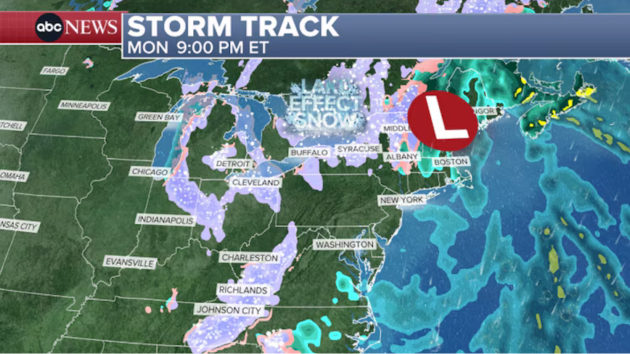How schools are struggling to serve lunch amid supply chain hurdles
Written by luck on October 18, 2021
(NEW YORK) — School routines have been upended amid the COVID-19 pandemic and as a result of recent nationwide supply chain problems, there are new challenges for free lunch programs.
From distribution delays and shortages of fresh foods to cafeteria supplies like trays and tongs, districts across the U.S. have had to rework breakfast and lunch options for students.
In Alabama, Alexander City Schools took to social media earlier this month to warn parents on Facebook that due to a lack of food deliveries from suppliers, their breakfast would be impacted in the coming weeks.
“In previous weeks we have not received our food deliveries due to suppliers who are short on supplies, drivers and even warehouse employees,” the Oct. 9 post said, adding that it opened accounts with outside vendors to get more supplies. “If possible, we ask that you feed your student breakfast prior to school or try to send a snack.”
The schools in Alexander City also had to alter their menus to fit the supplies they were receiving instead and notified parents of the limited menu selections, but confirmed that “at no time were our students not offered or served a meal for lunch or breakfast.”
“This is a situation that is frustrating for you as a parent, and for us as well as our ability to feed our students is being greatly impacted,” the post said.
Tonya Grier, a Child Nutrition Program Director for Dothan City Schools, told GMA its district, which is nearly three hours from Alexander City, has seen similar issues.
“Deliveries from our primary distributor continue to be unpredictable; we’re no longer confident of arrival until we see the truck at the back door. There are still multiple items (food and non-food) that are marked as “out” on our orders, but the vendor is working to find and offer substitutes for items that are in short supply from manufacturers,” Grier told GMA. “We are working to secure products from other distributors, but they too face the same challenges related to supply chain disruptions.”
“Particularly troubling is the shortage of supplies to serve food. We’re used to subbing out food items to make a menu; that happened occasionally even before COVID-19. But if we can’t get trays, cups, and cutlery to serve food to students, that’s a totally different challenge for us,” Grier said. “We serve an average of 9,400 meals a day (breakfast and lunch combined), and the volume of food and supplies needed to do that means going to our local grocery stores and warehouse club is not a viable option for us.”
Dothan Superintendent Dennis Coe told GMA that “the uncertainty of food supplies” has created “an extra layer of stress and anxiety for staff.”
“This exacerbates our existing difficulties in hiring qualified staff,” Coe said of the current issues facing the schools in Dothan.
The school district’s Public Relations Information Officer Megan Dorsey added that with students home for fall break until Oct. 20, they believe “some stress on food shortages” may be alleviated.
In September, the U.S. Department of Agriculture announced a $1.5 billion investment to provide assistance for schools to respond to supply chain disruptions and feed students.
“Throughout the pandemic, school food professionals have met extraordinary challenges to ensure every child can get the food they need to learn, grow and thrive,” the USDA said in a release. “But circumstances in local communities remain unpredictable, and supply chains for food and labor have been stressed and at times disrupted. These funds will support procurement of agricultural commodities and enable USDA’s Food and Nutrition Service (FNS) and Agricultural Marketing Service (AMS) to enhance the toolbox for school nutrition professionals working hard to make sure students have reliable access to healthy meals.”
School Nutrition Association President, Beth Wallace, hailed the waiver as “a huge relief for school nutrition professionals who are working so hard to serve our students healthy meals in the face of unprecedented challenges.”
Over the past several months, Wallace said their organization has scrambled “to secure foods and supplies for our students’ meals and re-working our menus when our orders have been canceled or deliveries delayed.”
A survey by the SNA heading into the 2021 school year found that 97% of school meal program directors nationwide were concerned about continued pandemic supply chain disruptions. Of those concerned, the SNA said 65% cited it as a “serious” concern.
Issues reported in the survey included “canceled orders, food and supply shortages, product substitutions, price increases, delayed and canceled deliveries often with little or no advance notice.”
Chalkbeat, a nonprofit organization that focuses on education news, started a self-submission form for parents, administrators and districts to report similar food program situations with respect to the supply chain woes.
In Newark, New Jersey’s largest district, Patrick Wall told GMA that shortages extend beyond just food and lunchroom supplies, but to cafeteria workers creating “horrible” lunch options for kids because it’s “difficult to prepare meals from scratch.”
“In response, the district has begun outsourcing some of its meal production. Last month, it made a $3.9 million ’emergency purchase’ of pre-made meals from a vendor,” he said.
Copyright © 2021, ABC Audio. All rights reserved.





